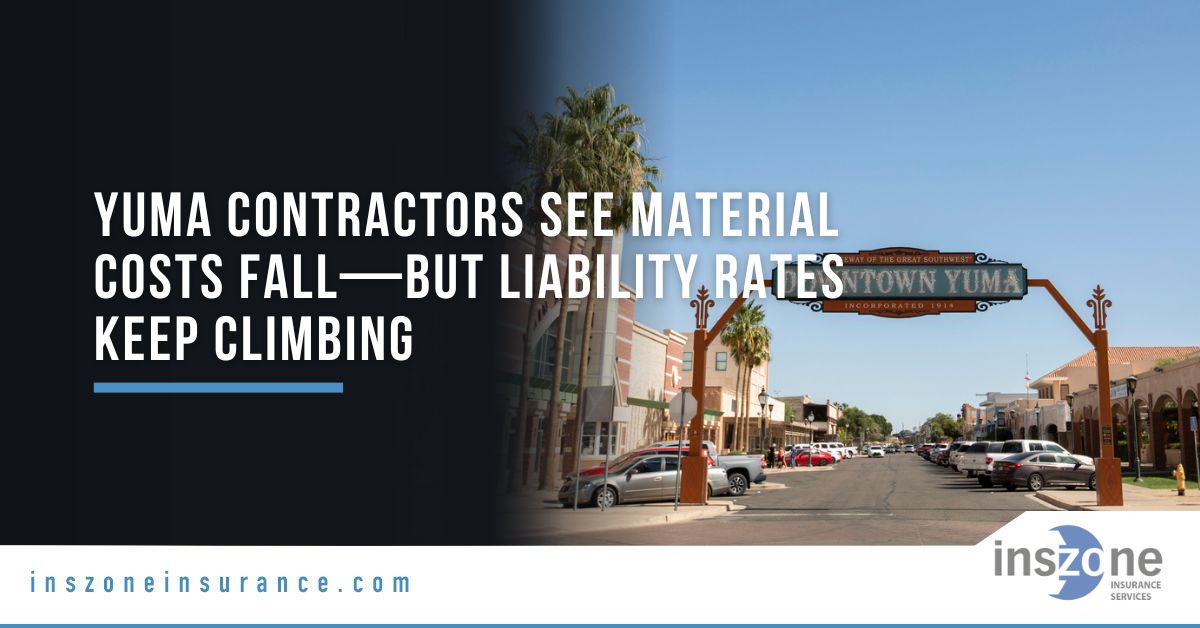A nuts-and-bolts guide for general contractors, specialty trade crews, and other small businesses bidding work in Yuma County.
What’s Happening in 2025?
- Material relief: Lumber futures slipped nearly 30 % from early-2024 highs, trimming bid costs on wood-frame jobs.
- Premium pressure: General-liability (GL) and builders-risk rates still climbed 7–12 % statewide, despite cheaper supplies.
- Small-biz snapshot: A typical Yuma operation now spends $400–$1,200 per year for basic GL, versus $500 statewide.
- Workers’ comp: Payroll-driven premiums ticked up after Arizona’s minimum wage rose to $14.70 on Jan 1, 2025.
Why Are Insurance Costs Rising While Lumber Prices Fall?
- Big jury verdicts: Construction-injury awards above $5 million pushed carrier loss ratios past 70 % in 2024.
- Reinsurance squeeze: Global treaties for construction liability renewed at +10 %, forcing retail hikes.
- Heat-stress exposure: OSHA’s pending national standard targets Arizona first; carriers now include “heat-plan” surcharges if you lack written protocols.
- Wildfire severity: Rural Yuma job-sites in WUI zones face higher property-damage deductibles and rate loads.
Who Pays the Most?
- Roofers, framers, and concrete crews—highest injury frequency and GL surcharges.
- Start-ups and one-person LLCs with no prior coverage history.
- GCs hiring uninsured subs; you’re billed for their payroll at audit if COIs are missing.
Where Can You Still Save Money?
- Audit your numbers: Verify payroll and gross-receipt estimates—overreporting is overpaying.
- Bundle a Business Owner’s Policy (BOP): GL + property can run $121 / month for contractors, 5–10 % less than separate policies.
- Safety credits: Written heat-stress plan, AI dashcams, and weekly toolbox talks can earn up to 10 % GL credit.
- Small wrap-ups (OCIPs): Projects in the $2–5 million range may insure cheaper under one wrap than stacking individual policies.
- Higher deductibles: Moving GL from $1k to $2.5k often trims 6–8 % without gutting court-fee protection.
When Should You Re-Shop Coverage?
- 90–120 days before renewal—lets underwriters review loss runs and quote competing carriers.
- After bid spikes or change orders—if contract value jumps 25 %+, report it to avoid audit shock.
- Right after major safety upgrades—submit proof immediately for mid-term credits.
How to Lock in Better Rates—Without Cutting Protection
- Schedule equipment under one inland-marine floater instead of separate tool endorsements.
- Add completed-operations limits only when needed; skip them if the owner’s wrap already covers post-work liability.
- Vet every sub: Require equal or higher GL limits and current COIs before the first draw is released.
- Document safety culture: Heat logs, fall-arrest training records, and incident-rate dashboards justify carrier discounts.
Key Take-Aways for Yuma Builders
- Budget for high-single-digit GL increases even as lumber gets cheaper.
- Early shopping + proven loss-control beat last-minute price hunts.
- Bundle smart, audit payroll, and show off your safety plan—those three moves offset most 2025 premium hikes.
Sources
- Allen Thomas Group – Business Insurance Costs in Yuma (2025)
- Insureon – Average Arizona Small-Business Insurance Costs (2025)
- Honigman – 2025 Construction Insurance Mid-Year Update
- Wall Street Journal – Lumber Prices Plunge on Housing Slowdown (April 2025)
- Industrial Commission of Arizona – 2025 Minimum-Wage Schedule
- OSHA – Proposed Heat Illness Standard Background (2024)
Need a line-item policy audit? Inszone’s Yuma construction team can review your coverage and find savings before bid season heats up.





